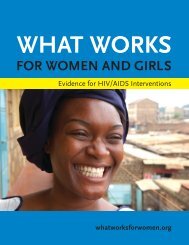Global Tuberculosis Report -- 2012.pdf
Global Tuberculosis Report -- 2012.pdf
Global Tuberculosis Report -- 2012.pdf
You also want an ePaper? Increase the reach of your titles
YUMPU automatically turns print PDFs into web optimized ePapers that Google loves.
CHAPTER 8Research and developmentKEY FACTS AND MESSAGES Conventional technologies have been constrainingprogress in TB care and control, but efforts to developnew TB diagnostics, drugs, and vaccines have intensifi edduring the past decade and considerable progress hasbeen made. WHO has endorsed several new diagnostic tests ormethods since 2007, including Xpert MTB/RIF that hasthe potential to transform TB care. Other new tests,including point-of-care tests, are in development. For the fi rst time in 40 years, a coordinated portfolio ofpromising new anti-TB drugs is in development, with 11new or repurposed anti-TB drugs in clinical trials. Results from two Phase III trials of 4-month regimensfor the treatment of drug-susceptible TB are expectedin 2013. In addition, 2 new compounds are beingevaluated for use as an adjunct to current optimizedregimens for MDR-TB; one compound recently movedto a Phase III trial and the other is expected to do sobefore the end of 2012. A new three-drug combination regimen that could beused to treat both drug-sensitive TB and MDR-TB andshorten treatment duration has been tested in a PhaseII study of early bactericidal activity, with encouragingresults. There are 11 vaccine candidates for TB prevention inPhase I or Phase II trials and one immunotherapeuticvaccine in a Phase III trial. It is hoped that one or twoof the candidates in a Phase II trial will enter a PhaseIII trial in the next 2–3 years, with the possibility oflicensing at least one new vaccine by 2020. Funding for TB research and development has increasedin recent years, but stagnated between 2009 and 2010.At US$ 630 million in 2010, funding falls far short ofthe annual target of US$ 2 billion specifi ed in the <strong>Global</strong>Plan to Stop TB 2011–2015.There has been major progress in TB care and controlsince the mid-1990s (Chapters 2–7). However, achievementof the Stop TB Partnership’s target of eliminatingTB by 2050 (Chapter 1) requires the development ofnew diagnostics, drugs and vaccines as well as better andwider use of existing technologies. For example, modelingstudies show that TB elimination by 2050 demandsa combination of improved diagnosis of drug-susceptibleand drug-resistant TB, better and shorter treatments forall forms of TB, treatment of people with latent TB infectionon a massive scale (especially in high-risk populations)and mass vaccination with a vaccine that is moreeffective than BCG. 1During the past decade, efforts to develop new diagnostics,drugs and vaccines for TB have intensified. Forexample, public–private partnerships have been createdto stimulate the development of novel tools for TB control.These include the Foundation for Innovative NewDiagnostics (in 2003), which works on the developmentof novel diagnostics for TB among a range of other diseases;the TB Alliance (in 2000), for new anti-TB drugs;and for new vaccines against TB, Aeras (in 2003) and theTB Vaccine Initiative (in 2008). The Stop TB Partnershipincludes three working groups for new diagnostics,new drugs and new vaccines, which represent importantforums for exchanging information and promotingresearch.Funding for TB research and development increasedfrom US$ 363 million in 2005 to US$ 630 million in2010 2 but stagnated between 2009 and 2010. The 2010level of funding falls about US$ 1.4 billion per year shortof the needs described in the <strong>Global</strong> Plan to Stop TB 2011–2015. 3 Major sources of existing funding include the UnitedStates National Institutes of Health/National Instituteof Allergy and Infectious Diseases (NIH/NIAID), the Bill& Melinda Gates Foundation, the European Commission(including the European Developing Countries ClinicalTrials Partnership, EDCTP), USAID and DFID, as well as1Abu-Raddad LJ et al. Epidemiological benefits of more effectivetuberculosis vaccines, drugs and diagnostics. Proceedingsof the National Academy of Sciences of the United States of America,2009, 106(33):13980–139805.2Jiménez-Levi E. 2011 <strong>Report</strong> on tuberculosis research fundingtrends, 2005–2010, 2nd ed. New York, NY, Treatment ActionGroup, 2012.3The <strong>Global</strong> Plan to Stop TB, 2011–2015. Geneva, World HealthOrganization, 2010 (WHO/HTM/STB/2010.2).82 GLOBAL TUBERCULOSIS REPORT 2012
















